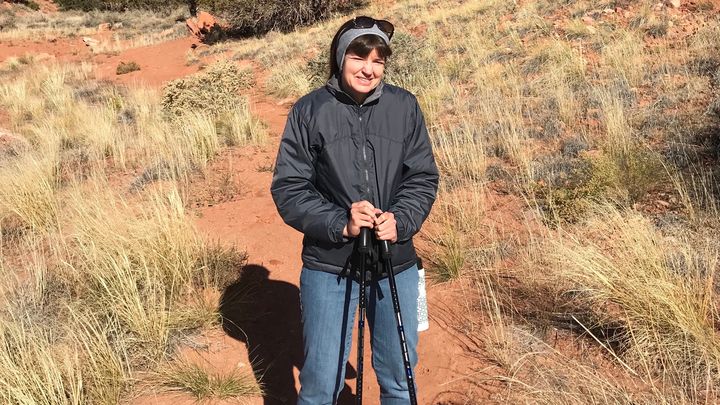
Help Anika Keep Working, Slow the hEDS Progression
Donation protected
Quick Summary: The connective tissue in Anika’s upper spine is so damaged, the vertebrae have begun to pinch on her spinal cord! This causes intense pain and motor control problems. Timing is crucial with prolotherapy treatments. Stopping mid-stream could actually make her condition worse. But right when she needs to move forward, she’s hit a financial wall. Help us, help Anika!
Also, contact us (below) if you or someone you know has similar symptoms aggravated by COVID-19. Anika would like to connect with them. She is gathering case stories for a book about COVID’s effects on people with hEDS and other connective tissue disorders. Please spread the word!
THE DETAILS...
A Long-COVID Medical Mystery, Finally Solved
Three years ago, our friend Anika caught a post-vaccination case of COVID-19 and never quite got better. Her “Long-COVID” symptoms weren’t typical. She struggled with balance and coordination problems, motor control of her arms and left leg, nausea, trouble swallowing, and nerve pain in her limbs and face, as well as typical Long-COVID fatigue.
Her family doctor speculated that COVID-19 poured fire on some underlying genetic or autoimmune condition. That proved true, but it took a year of specialist appointments to reach an accurate diagnosis: Ehlers-Danlos Syndrome, specifically the hypermobile form (hEDS).
While hEDS often harms the ligaments around major joints, for Anika, this condition has degenerated the connective tissue that stabilizes her spine. Multiple vertebrae now shift and pinch on the spinal cord and branching nerves, or hinder the flow of cerebrospinal fluid.
That can be really painful—daily migraine-like headaches and sudden nerve pain. Or it can cause motor control and balance problems. Particularly, any time Anika bends her neck or works with her hands (think: writing, editing, cooking, domestic tasks), this can trigger fiery pain and coordination problems. You can only imagine how this “invisible disability” affects her ability to work as a writer and care for herself each day.
The Good News and the Difficult News
Finally, Anika knows what’s wrong, and she’s found more appropriate care. There is really only one non-invasive direct treatment for hEDS: Prolotherapy . This involves injections near the damaged areas. When successful, it thickens and stabilizes weak ligaments and other connective tissue.
Anika has worked with a physician in Helena, Montana for about a year, administering these injections along her spine, working from low back on up. So far, she is responding well. The treated areas have significantly improved based on ultrasound and strength testing. That’s fantastic. But the most life-limiting symptoms come from her neck where the vertebral instability is the worst. Dr. Steele couldn’t work safely on her upper spine till the instability lower down was addressed. Finally, he’s ready to start work on those serious problem areas this month!
But now the bills have piled up. Prolotherapy is considered “experimental”. Though it’s the only non-invasive direct treatment available for hEDS, it’s not covered by insurance. At least Anika was told the diagnostic visits and ultrasound evaluations would be covered. But her insurance took over six months to process several claims and, recently, a number of office visits and services that she was told would be “covered” weren’t really covered at all. Insurance covered just pittance amounts of the bills.
An Insurmountable Wall, Right When She Needs to Move Forward
Right when Anika is about to start treatment on the region of her spine that is causing the most life-limiting symptoms, she finds herself saddled with about $7000 in medical debt, and another $8000 on the horizon.
At the same time, a couple of her best ghostwriting and editing clients have been affected by recent layoffs. Her already low income just got slashed again.
To add to the stress, time is of the essence with prolotherapy treatments. When you stabilize one spinal region in an hEDS patient, you can actually provoke more instability in adjacent regions. So, it’s crucial to stabilize each region sequentially and promptly. If Anika doesn’t receive the prolotherapy injections in her upper spine soon, the instability there could actually get much worse.
How the Funds Will Be Applied
We want this GoFundMe campaign to cover Anika’s current medical bills and the remainder of her prolotherapy treatments and evaluations ($15,000.00 total). We also want to include a buffer amount ($6,000.00) so she can cover her deductible for other supportive care (weekly PT, OT, hEDS specialist visits) and possibly a more expensive platlet-rich plasma (PRP) injection if her upper spine needs more focused care.
So far, Anika is responding well to prolotherapy. This initial success indicates she will experience significant improvement as far as nerve pain and motor control problems coming from her upper spine. We definitely don’t want her to stop treatment mid-stream and risk having things get worse.
Please help us help Anika!
Gratefully,
Cindy, John, ‘Erie, Katja, and Mikey
Organizer and beneficiary
Cynthia Lewis
Organizer
Belgrade, MT
Anika Hanisch
Beneficiary